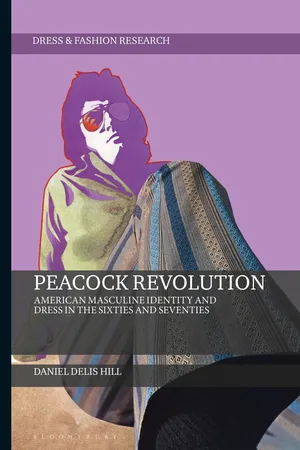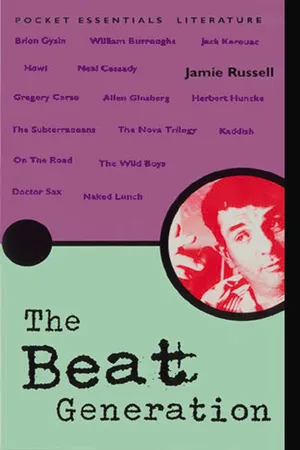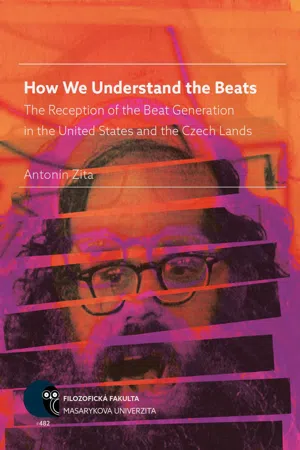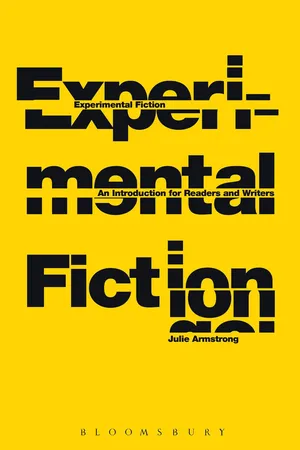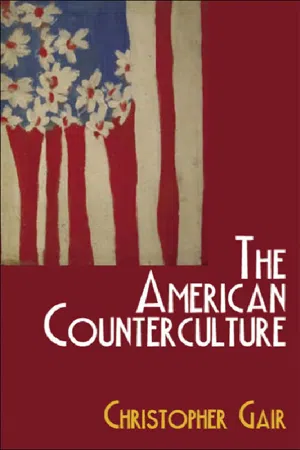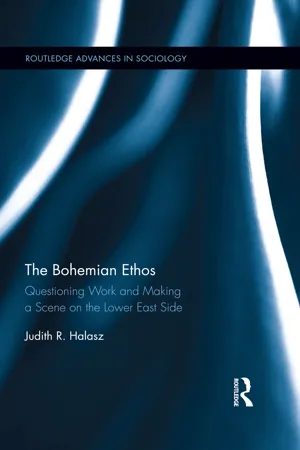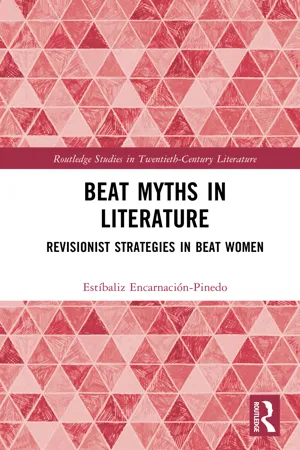Literature
Beat Generation
The Beat Generation was a literary movement of the 1950s that rebelled against societal norms and embraced spontaneity, personal expression, and non-conformity. Writers like Jack Kerouac, Allen Ginsberg, and William S. Burroughs were central figures, and their works often explored themes of alienation, spirituality, and the search for meaning in a post-World War II society.
Written by Perlego with AI-assistance
Related key terms
1 of 5
9 Key excerpts on "Beat Generation"
- eBook - PDF
Peacock Revolution
American Masculine Identity and Dress in the Sixties and Seventies
- Daniel Delis Hill(Author)
- 2018(Publication Date)
- Bloomsbury Visual Arts(Publisher)
The Beat Generation In middleclass America, the leading edge of the postwar counterculture developed principally with the educated intellectuals and young writers who had congregated in the bohemian sections of New York and San Francisco in the years just after the Second World War. The group of nonconformist poets and writers that included Allen Ginsberg, Jack Kerouac, William S. Burroughs, and Neal Cassady, among others, identified themselves as the Beats, a name credited to Kerouac in 1948. 1 The moniker encompassed three derivations. At the time, the word was used as slang by drug addicts and gay-for-pay hustlers to mean “down and out”—cheated, robbed, or drained emotionally and physically. Somewhat related, the term was also used to describe the group’s feeling of being beaten down and marginalized by a conformist society, oppressive politics, the police, and by life itself. But to Kerouac, the word also had a special spiritual significance he called “beatific,” meaning “a holiness that came with being among the downtrodden masses,” including “lost sailors, dusty hoboes, drunk and despondent husbands, disillusioned soldiers, and truck stop diner customers.” 2 The Beats achieved national notoriety in the mid-1950s by holding readings of their work in cafes and loft parties. In 1956, psychotherapist Paul Goodman included the Beat Generation in his study of American youth: “Beat style . . . tries to be an action, not a reflection or comment . . . Their persistent effort at the effective community reading, appearing as themselves in their own clothes, and willing to offend or evoke some other life response . . . are efforts for art and letters as living action.” 3 The Beats were not the social activists and protesters that the youthquake generation would become in the 1960s. Instead, concluded 2 NEW MASCULINE IDENTITIES IN THE POSTWAR COUNTERCULTURE 32 PEACOCK REVOLUTION Goodman, “Their politics are unimpressive. - eBook - ePub
- Jamie Russell(Author)
- 2012(Publication Date)
- Pocket Essentials(Publisher)
5. The Beat Generation MovementWhile Kerouac, Ginsberg and Burroughs are the names most often associated with the Beat Generation, they are actually just the most recognisable personalities of a literary and social movement that included many more (less well-known) writers and artists. In the early days of the Beat Generation, around the late-1940s and early-1950s, the movement didn’t extend much further than the friendship of Kerouac, Ginsberg and Burroughs. But as the media turned the Beats into a social phenomenon, the Beat lifestyle suddenly swept across America’s cities and into the rest of the world. A whole generation of artists, writers and musicians saw their own concerns reflected in the Beat Generation and pledged allegiance to the Beats’ challenge to straight society.Nelson AlgrenThe Beats found friends and followers in all walks of the arts. Sadly there’s not space here to list all the musicians, painters, poets and even stand-up comedians who they influenced. But the writers in this chapter are the key members of the Beat movement, the ground troops who acted as muses, fellow artists and political agitators (and sometimes all three). Many of them were there from the start (Herbert Huncke, John Clellon Holmes), while others form a bridge between the Beats and the hippies (Neal Cassady, Alexander Trocchi). Some deserve an honorary mention simply because they were influenced by the Beat movement and often carried the Beatnik flag (Norman Mailer, Hunter S Thompson).Although not usually mentioned as a member of the Beat Generation, Nelson Algren (1909-1981) deserves credit as one of the few American novelists, pre-Beat, willing to tackle the growing world of post-war subcultures. Born in Chicago, Algren charted the wild side of the concrete jungle in his novels. He remains most famous in literary circles for his love affair with Simone de Beauvoir, the French feminist writer and lover of Jean-Paul Sartre. - eBook - PDF
- David Burner(Author)
- 2021(Publication Date)
- Princeton University Press(Publisher)
While the civil rights movement in its early days was probing be-yond the limits of settled social reality, the Beat Generation was compos-ing works that would contribute in their own ways to the widening of sensibilities in the years to come. The first impressions a reader will take from the best-known writings of the Beats are rootlessness, rebellion, great gobs of primal undigested experience, and in the generation's chronicler novelist Jack Kerouac a 114 CHAPTER IV vigor and sense of the open land suggestive of Jack London. Other read-ings yield subtler moods. The lost sound of jazz drifting above the city from the back rooms of the poem's seekers catches one tone of Allen Ginsberg's Howl (1955). Kerouac's novel The Dbarma Bums (1958) por-trays a search for moments as finely etched as a Japanese watercolor, immaculate like the pure mountain water in which the two central char-acters brew cups of tea. No single theme predominates in Beat writing, nor was all the Beat rebellion on the political left. While Ginsberg was an antiwar activist, Kerouac admired William Buckley and supported the war in Vietnam. William Burroughs could be something of a reactionary. The rebellion, rather, was against what the authors took to be the timo-rousness of the nation's culture, the narrow limits it placed upon expe-riencing. They sought, and stored reflectively in their writings, experience gained in encounters with the physical world—archetypically, a car crav-ing its way through the bountiful continent that had once sustained among the pioneers and then the hoboes a restless American folk culture. And in the belief that experience, mundane or mystical or in whatever conjunction, lies for the taking beyond the bounds imposed by social con-ventions, the Beats anticipated a decade that was to be about the ruptur-ing of boundaries. In 1957 a substitute book reviewer at the New York Times, Gilbert Millstein, wrote a favorable review of Kerouac's powerful novel On the Road. - eBook - PDF
How We Understand the Beats
The Reception of the Beat Generation in the United States and the Czech Lands
- Antonín Zita(Author)
- 2018(Publication Date)
- Masarykova univerzita(Publisher)
14 1 Introduction to the Beat Generation significantly from one another. Kerouac, for instance, tried to advance his writ- ing philosophy dubbed “spontaneous prose,” that is an approach which favored improvisation and free writing. In contrast, Burroughs preferred disjointed nar- ratives that resist a straightforward interpretation, as exemplified by his “cut-up” method which involved inserting scrambled portions of other authors’ texts into his own writing. Finally, Ginsberg’s poetry often mixes cries of social injustice and protest with religious imagery, thus leading Ginsberg to categorize himself as a visionary poet in the tradition of William Blake or Antonin Artaud (Portugés 3). The differences are obvious even when comparing only the Beat poets: apart for their disdain for formalist rules of poetry writing, their approaches to writing vary substantially from one another. As a result, Beat poetry includes Snyder’s eco-consciousness with Eastern influences as well as Corso’s playful portrayal of everyday experiences. 1.2 The Beat Generation as an Attitude In other words, what the term “Beat” or “the Beat Generation” actually stands for frequently varies from person to person. Nevertheless, there is a shared thread running through the definitions of the term and the various approaches to the Beats: that of communitarian identity positioning itself as the direct opposite of the public. As Barry Miles explains, it was a “fraternity of spirit and attitude” that connected the New York Beats together (El Hombre 2). - eBook - PDF
Experimental Fiction
An Introduction for Readers and Writers
- Julie Armstrong(Author)
- 2014(Publication Date)
- Bloomsbury Academic(Publisher)
Indeed, movies were celebrated throughout this period, with the likes of Marilyn Monroe and James Dean becoming glamorous movie star sensations. In addition, a number of television shows were produced, which portrayed a romanticized view of middle-class life, for example, Father Knows Best . Comic book audiences grew. When Were/Who Were the Beats? 59 Characters such as Flash Gordon , Peanuts and Dennis the Menace were amongst the favourites. Science fiction and superman comics were in abundance, too. Music flourished, especially jazz, popular and country music, and then, in the mid-1950s, Rock-n-Roll emerged, Elvis Presley being the superstar of the period. In terms of high art, the focus for artistic practice switched from Paris to New York with the advent of artistic Abstract Expressionism. And so, for the middle-class Americans living through the 1950s, life was more secure, prosperous and culturally rich than the previous years. However, it was a lifestyle vehemently rejected by the Beats, in favour of a very different one. Who were the Beats? The Beat Generation, then, was a term used to describe a group of American writers who came to prominence in the 1950s, writers who provided a counter-culture to Cold War politics and a social commentary on the hip youth culture of the 1950s, both of which they captured in their experimental writing practice. Although the philosophy of the Beats was considered to be anti-academic, the seeds for the Beat movement were sown in an academic environment, as they originally met at Columbia University in the early 1940s. This was where the charismatic Lucien Carr and Allen Ginsberg, following nights of drinking and reading works such as Seasons in Hell by the nineteenth-century poet Arthur Rimbaud (whom Carr considered to be a doppelganger), discussed the need for a new vision for art. This vision was not formulated with intellectual rigour. - Jimmy Fazzino(Author)
- 2016(Publication Date)
- Dartmouth College Press(Publisher)
literary studies toward a transnational understanding of cultural production. Though long regarded as quintessentially “American,” the mid-twentieth-century countercultural phenomenon known as the Beat Generation is not only what we would now recognize as a transnational literary movement par excellence but is thoroughly worlded in all the ways that I attempt to describe in this book. Situating my work in rela-tion to the burgeoning feld of Beat studies as well as the much broader zone defned by the transnational turn in the humanities, I argue that the study of Beat writing offers new approaches for transnationally minded criticism in the twenty-frst century. As approaches to Beat Generation writing become more theoretically capacious, and as the study of the Beats seems to be increasingly legiti-mated within the academy, critics reach a point where merely refecting on what it means to be “Beat,” asking who was or was not a Beat, or calculating when the Beat movement can be said to have begun or ended will no longer suf fce. A collections of essays edited by Jennie Skerl and published in 2004, Reconstructing the Beats , called attention to the lim-itations of Beat scholarship and began to challenge the adulatory my-thography that has characterized the study of Beat writing.- eBook - PDF
- Christopher Gair(Author)
- 2007(Publication Date)
- EUP(Publisher)
Music: 1945^1960 Williams and Hart Crane, contributed to the emphasis on personal, often confessional, texts such as ‘Howl’ and On the Road . Like Whitman, the Beats were happy to collapse the divide between high and popular culture, being as willing to celebrate The Shadow (Ker-ouac, Amiri Baraka) or Lana Turner (Frank O’Hara) as to cite Melville or Pound. This concern is extended in the practice of incorporating American idioms and vernacular into almost all Beat novels and poems. Likewise, as we have seen in the previous chapter, Beat writers regularly explored African-American and other ‘ethnic’ cultures as alternatives to the monochrome lifestyle they identified in white America. Although there were dangers in their approach to otherness, with the risk of what James Edward Smethurst has called ‘Romantic-inflected primitivist notions of race and ethnicity . . . that we might well consider essentialist or racist’, Smethurst asserts that Beat ap-proaches were ‘frequently far more nuanced and provisional’ than is generally argued, a point largely supported by the readings I have offered in the previous chapter. 4 Within this more general interest in African-American art and culture, of course, the Beats displayed an almost obsessive fascination with bebop and its star performers, most notably Charlie Parker. In part, this was a result of a shared desire to explore new possibilities in art, drawing on years of training – as musician, writer, painter, actor, and so on – in order to generate an immediate, improvised and apparently ‘spontaneous’ product. In addition, there was a recognition by writers such as Kerouac and Ginsberg that bebop was a music of non-conformity, ‘weird’ – as LeRoi Jones puts it – to middle-class white and black Americans alike. 5 If the Beats had removed themselves from the mainstays of dominant ideology, then the same could also be said of the beboppers who, from the early 1940s, challenged the norms of jazz and swing. - eBook - ePub
The Bohemian Ethos
Questioning Work and Making a Scene on the Lower East Side
- Judith R. Halasz(Author)
- 2015(Publication Date)
- Routledge(Publisher)
The 1960s A Generation in RevoltI could never finally figure out if more things happened in the sixties because there was more awake time for them to happen in (since so many people were on amphetamine), or if people started taking amphetamine because there were so many things to do that they needed to have more awake time to do them in.—Andy Warhol (1980, 33)The previous chapter established the political valence of the literature and everyday lives of the Beat Generation, an assessment not shared by all scholars, literati, or bohemians. By contrast, the unconventionality, rebelliousness, and political character of the 1960s countercultural generation is generally taken for granted. Many scholars, political radicals, and bohemians say that bohemia peaked in the 1960s in terms of the scale of participation; the breadth of artistic innovation; the articulation of opposition to middle-class practices, institutions, and values; and the interconnectedness of political and cultural radicalism (Esler 1971; Hoffman 1971; Miller 1977; Warhol 1980; Di Prima 2001; Schwendener 2001). The counter-culture challenged stale conventions of proper appearance and behavior; reconsidered the taken-for-granted life course of career, family, and retirement; and organized to repeal institutionalized inequalities of race, ethnicity, class, and gender. In a sense, they were rebelling against a 1950s Leave It to Beaver mode of existence. In nearly every aspect of social life, questioning the status quo was de rigueur. According to a veteran of the counterculture, “bohemia became the lifestyle.”There were three tendencies within the counterculture: one political, another aesthetic, and the third lifestyle-based. A complex relationship formed among the three tendencies, which did not necessarily constitute distinct social groups. The overlap of individual membership and the consonance of political orientation among the tendencies promoted sharing protest strategies and leading similar lifestyles. Because of the connections and commonalities, authorities often treated the three tendencies as interchangeable. Radical, new journalist, folk-rock musician, queer pop artist, hippie—they were all seen as “long-haired Commi freaks,” never mind the obvious differences. - eBook - ePub
Beat Myths in Literature
Revisionist Strategies in Beat Women
- Estíbaliz Encarnación-Pinedo(Author)
- 2023(Publication Date)
- Routledge(Publisher)
6 Memoir and Writing (the) BeatDOI: 10.4324/9781003223238-6In the “Essentials of Spontaneous Prose” (1955) Jack Kerouac championed personal experience by stressing the writer’s need to “[b]e in love with your life, every detail of it” (Charters, Selected Letters 487), to write about “the unspeakable visions of the individual” (487), and to feel “[n]o fear or shame in the dignity of your experience, language & knowledge” (487). This apparently all-inclusive call for personal experience led to an aesthetic where Beat poets and writers frequently used their writing to particularize their personal stories, giving rise not only to candidly personal poetry and fiction, but also to first-person accounts in the form of journals, collected letters, autobiographies, and memoirs. While this is true for both men and women, as the previous chapter has shown, the highly masculinized Beat circle did little to reverse the historical devaluation of female experience. The early reception of the memoirs written by women associated with the Beat Generation attests to the diminished value of female experience within the movement. The 1976 introduction to Carolyn Cassady’s Heartbeat, written by John Clellon Holmes—author of the proto-Beat novel Go—is quite revealing in this sense. Holmes aptly begins his introduction by exposing the marked masculine dominance in the Beat literary world, noting that(i)the chronicles of the Beat Generation have been almost exclusively written by men. The restless search for those illuminations of the spirit via the senses that characterized the Beats has been mostly depicted from the vantage point of the young men of the 1940’s and 50’s. Now, with Carolyn Cassady’s book, we have the first account of those eruptive years as experienced by a woman.This rather promising start seems to draw attention to the need of including female experience in the history of the Beat Generation. However, in a move that will come to be characteristic of the reception of the memoirs, it soon becomes clear that the value to Cassady’s experience lies solely in what she can add to the knowledge the reader already has about Jack Kerouac, Allen Ginsberg, and Neal Cassady. Given the right to speak as wife of Cassady and lover to Kerouac, her account is not valued as the representation of an alternative or parallel female experience; but merely praised for its ability to offer insight into the lives of major figures of the movement. Not surprisingly, the rest of Holmes’s introduction is dedicated to the men, with Carolyn providing the connecting link. When Holmes finally gets back to Carolyn at the end of the introduction, he does so only to stress the two qualities he values the most in her memoir: her “reflectiveness” and her “quietness”. These nouns compromise the expression of her authorial voice, turning her account into a reliable—read passive and objective
Index pages curate the most relevant extracts from our library of academic textbooks. They’ve been created using an in-house natural language model (NLM), each adding context and meaning to key research topics.
